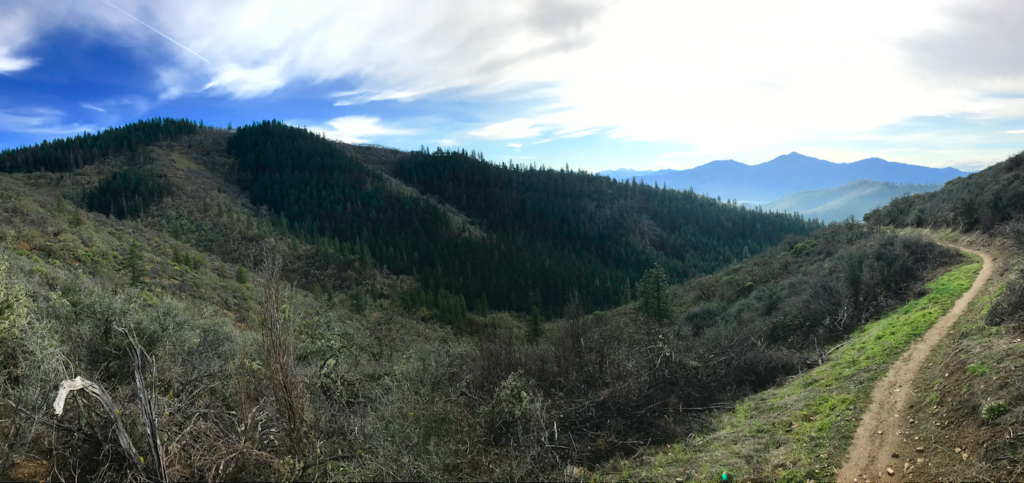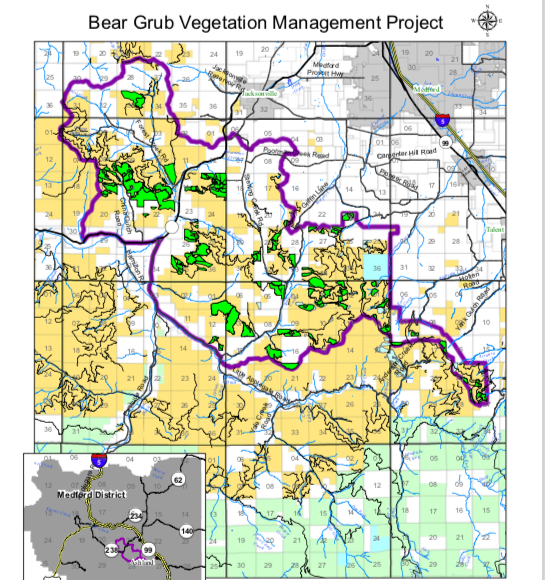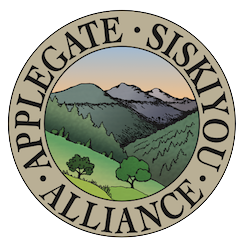
Do you love the East Applegate Ridge Trail and the forests of the Applegate? With your help we can defend Applegate forests from BLM logging.
The East Applegate Ridge Trail
As a recent addition to our local trail network, the East Applegate Ridge Trail (East ART) quickly became one of the most popular and cherished outdoor recreational experiences in the Applegate Valley and southwestern Oregon. With abundant community support, the Applegate Trails Association worked for many years to design the trail, secure BLM approval, fund, and build the East Applegate Ridge Trail. Local residents and visitors now enjoy the trail for its accessibility, incredible vistas, open grasslands, oak woodlands, chaparral stands and low elevation forests. It is a treasure of the Applegate Valley and a source of pride for our local community.

The Bear Grub Timber Sale
Unfortunately, the beautiful low elevation forests either on or adjacent to the East Applegate Ridge Trail are proposed for logging in the BLM’s new Bear Grub Timber Sale. The timber sale extends from China Gulch west of Ruch to Forest Creek, Poorman’s Creek, Sterling Creek and the mountains above Talent, Oregon in the Rogue Valley.

The forests of the Bear Grub Timber Sale and the impact of logging
The dry forests in the area include mature mixed conifer forests with scattered old-growth trees. They cling to protected north- and east-facing slopes within a diverse habitat mosaic of oak woodland, chaparral and dry grasslands. The Bear Grub “planning area” supports the driest forested habitats in Western Oregon. This aridity makes the forests of the Applegate foothills particularly susceptible to microclimate alterations associated with commercial logging.
In these dry forests logging that removes excessive levels of canopy and large dominant trees can often lead to accelerated overstory mortality (i.e. even more trees die after logging operations) and stand desiccation, as well as dramatic increases in understory fuel loads and fire risks. The Bear Grub Timber Sale is a particularly troubling example of this phenomena as it is located adjacent to many homes and residential areas around Ruch and the Little Applegate Valley.

Expediting the process and ignoring the public
For many years ANN has been advocating for land management activities that sustain our environment, maintain our biodiversity, protect wildlands, reduce fire risks to nearby communities, and address the concerns of the Applegate Valley community; unfortunately, in the Bear Grub Timber Sale, the BLM is heading in the opposite direction. In fact, the project marks a troubling transition towards heavy industrial logging and represents a lack of commitment to community collaboration and engagement. Not only has BLM been planning this timber sale without notifying or engaging community interests or neighboring landowners, they have also failed to schedule a single public meeting about this potentially damaging project. ANN is aware that local landowners living adjacent to Bear Grub units in the Applegate Valley have reached out to the BLM requesting a public meeting. ANN has also contacted local BLM officials on six occasions since November 2019 requesting a public meeting, yet the BLM has failed to accommodate the requests of local residents for a public meeting about the Bear Grub Timber Sale.
Despite essentially no public outreach, transparency or collaboration occurring around the Bear Grub Timber Sale, the BLM is expediting the process and has already begun marking unit boundaries and trees proposed for removal.
The return of clearcut logging on public lands in the Applegate Watershed
Although only some of the units located on or near the East Applegate Ridge Trail have been marked for tree removal, a clear pattern is evident: the Bear Grub Timber Sale is implementing “group selection” logging, a form of incremental clearcut logging. Under a “group selection” prescription, numerous patches of mature forest up to 4 acres can be marked for complete or near complete removal in each logging unit. These small clearcuts can be scattered throughout large patches of forest and can occur on up to 30% of a given timber sale unit. It is likely that group selection logging will be used throughout the entire Bear Grub Timber Sale, and not just in the area of the East Applegate Ridge Trail.
How group selection logging works: For example, if the BLM identifies a 100 acre unit of mature forest, 30 acres could be completely removed in a patchwork of clearcuts rather than in one large “cut block.” The guidelines for group selection logging (i.e. small clearcuts) are outlined in the BLM’s 2016 Resource Management Plan (RMP) and are being proposed in the Bear Grub Timber Sale.
The Bear Grub Timber Sale will increase wildfire risks to adjacent property owners and communities
The loss of canopy from group selection logging will dramatically increase wildfire risks by increasing understory fuel loads and removing whole groves of fire resistant trees. The group selection cuts will also increase sunlight, ambient air temperatures and wind speeds within “treated” stands, creating the potential for more intense fires and drier forest fuels.

Each opening created through “group selection” logging will respond with a profusion of understory fuel in the form of regenerating thickets of woody shrubs, young hardwoods and highly flammable young conifer saplings. If less than 150 young trees per acre do not regenerate, the BLM will plant them, creating a plantation-like structure that is particularly susceptible to high severity fire effects. Rather than reducing fire risks the logging will create conditions highly conducive to fast moving, high severity fires.
We are hearing reports from concerned community members in the Applegate that BLM is marking timber sale unit boundaries in advance of the Bear Grub Timber Sale. Many Bear Grub units will be located directly adjacent to homes and residential communities. If these timber sale units are implemented, fire risks will be heightened in communities around the Applegate Valley. ANN has been out to visit some of the units next to homes and private properties and we will continue to ground-truth as the timber sale marking progresses. Are you seeing BLM property boundary marking next to your land? If so, let us know at: info@applegatesiskiyoualliance.org
Climate, carbon and the Bear Grub Timber Sale
The Bear Grub Timber Sale will have disastrous consequences for the climate and the ability of local forests to absorb carbon from the atmosphere. By clearing up to 30% of mature forest stands, the project will not only release carbon into the atmosphere, but it will also limit carbon sequestration across vast tracts of BLM land in the Applegate Valley by removing large, old trees. Without a doubt, the Bear Grub Timber Sale will be a net loss for our climate. In fact, recent research conducted at Oregon State University demonstrates that industrial logging is the top producer of greenhouse gas emission in Oregon, accounting for up to 40% of all carbon emissions in the state.
To help prevent the worst impacts of climate change we need to be managing our forests for maximum carbon sequestration, which can be achieved by maintaining mature forest habitats. The amount of carbon sequestered by forest ecosystems plays an important role in regulating atmospheric levels of carbon dioxide. The potential to store additional carbon in Pacific Northwest forests is among the highest in the world; therefore, forest defense is climate defense.
Impacts to Wildlife
Group selection logging by its very nature will fragment and degrade forest habitats, creating an abundance of small clearcuts throughout otherwise mature, closed canopy forest. This will impact denning and resting habitat for the Pacific fisher, as well as, nesting, roosting and foraging habitat for the threatened Northern spotted owl. Great grey owls are known to nest in the area and will be impacted by the loss of canopy and forest habitat. Long-term snag and coarse wood recruitment will also be impacted, degrading habitat for terrestrial salamanders, bats, cavity nesting birds, raptors, and other wildlife species.

The thermal cover associated with mature forest is also important for temperature moderation during both the summer and winter months, providing protection for the region’s wildlife. Thermal cover requires closed canopy habitat conditions over relatively large areas and is an important habitat component for deer, elk, black bear and other wildlife species. Group selection logging would eliminate thermal cover in many stands by significantly fragmenting forest canopies.
Community Impacts
Group selection logging in the Bear Grub Timber Sale will also damage the scenic beauty of the East Applegate Ridge Trail, including its spectacular vistas and mature mixed conifer forests. The impacts to this popular trail will degrade the quality of life for Applegate and Rogue Valley residents and visitors who regularly hike, mountain bike, ride horseback through the forests of the area, or hang glide off Woodrat Mountain .

The Bear Grub Timber Sale represents the reintroduction of clearcut logging on public lands in the Applegate Valley and is a massive step backwards for the BLM. It demonstrates that timber values, not fuel reduction or “forest restoration” are driving forest management on the Medford District BLM. Please help us protect the forests of the Applegate Valley. Support outdoor recreation, fuel reduction and fire resilient communities. Stop Bear Grub!
Stay tuned as ANN schedules upcoming hikes into the Bear Grub Timber Sale and a public meeting about the Bear Grub Timber Sale in Ruch. With your help we can protect the beautiful forests of the Applegate and the East Applegate Ridge Trail!

To review or download the BLM’s publicly available information and maps follow this link.


One thought on “Bear Grub Timber Sale: Save the East Applegate Ridge Trail from logging!”
Comments are closed.